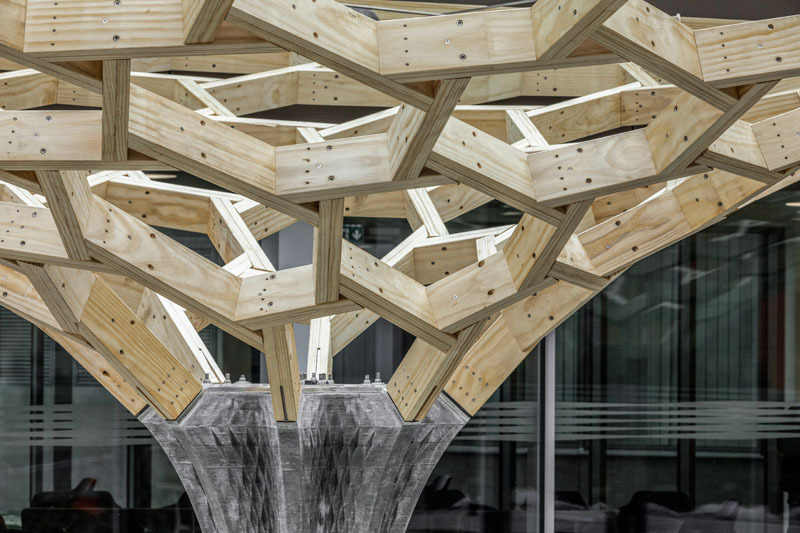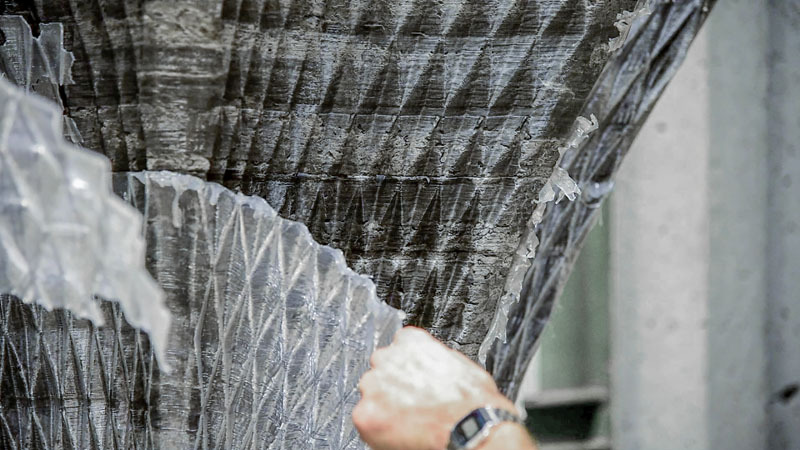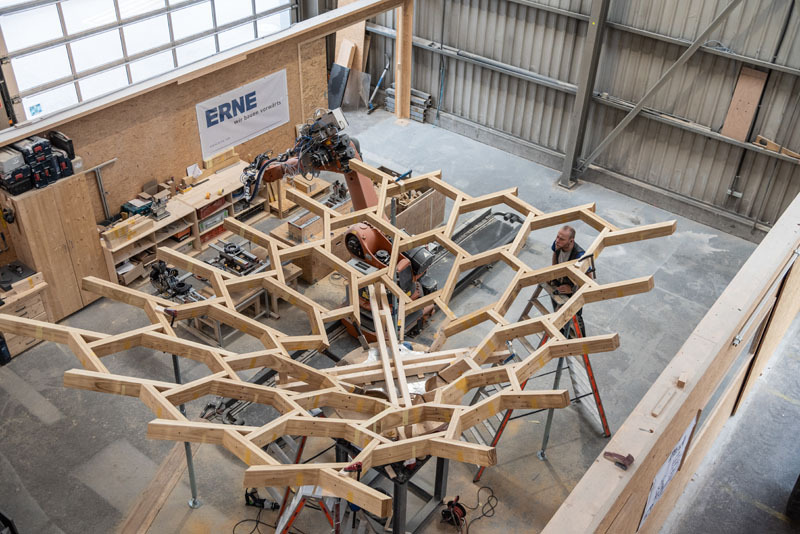14.07.2020
Future Tree: Robotic timber meets digital concrete
Demonstrating the latest research from NCCR Digital Fabrication researchers at ETH Zurich, Future Tree combines state-of-the-art design techniques, material science and robotic fabrication into an eye-catching architectural object. The structure, completed in the end of 2019, is located in Esslingen, Switzerland and stretches over the courtyard of Basler & Hofmann, the client and project partner.
Future Tree consists of a funnel-shaped, lightweight timber frame structure built by a robot and a bespoke concrete column created using an ultra-thin 3D printed formwork. The entire design and fabrication were developed as inseparable and fully digital processes.

Timber reciprocal frame structure
The canopy of the Future Tree is a reciprocal frame spanning over an area of 107 m2 and made of 380 acetylated timber elements that are butt-jointed using screws.
Every element has a unique geometry and is cut just-in-time and positioned by a robot according to data drawn directly from the digital model. This eliminates the need for parts logistics and excessive rationalisation, and facilitates non-standard, structurally optimised designs.
The structure rests on the concrete column and is additionally anchored to the building on two sides and cantilevering on the opposite corner. Thanks to the specific arrangement of its elements, a reciprocal frame can achieve a much larger span than the size of the elements would otherwise allow. Here, motivated by the frame’s structural behaviour, the honeycomb pattern gradually transforms between a hexagonal and a triangular in order to achieve varying levels of flexural rigidity in different areas of the frame. The increasingly triangular configuration in the cantilevering corner makes this area stiffer and locally minimises structural deformations.

Fully automated data exchange through parametric design
To take advantage of such phenomena they first have to become apparent and quantifiable to the designers. In order to study many instances of the design, the entire geometry and evaluation of the structure was programmed (described with an algorithm), including an automated data exchange between the architect’s modelling software (Rhino) and the engineer’s structural analysis application (Sofistik, Autodesk RSA). The computational model also facilitated a concurrent design approach, allowing to solve and coordinate different levels of details (LODs) and disciplines at the same time. For example, geometry of the screws connecting the timber elements was developed in parallel to the overall design, so that both structural integrity, architectural design but also fabrication feasibility could be continuously assured.
A novel fabrication process for concrete structures
The Future Tree’s stem is a reinforced concrete column, made using an ultra-thin formwork, 3D-printed by a robot, and filled with a custom developed fast-hardening concrete. This novel fabrication process, known as “Eggshell”, allows for the fabrication of non-standard, structurally optimised concrete structures, whilst being able to integrate standard reinforcement and minimise formwork waste. The Eggshell process makes use of fused deposition modelling (FDM) 3D printing in order to achieve a wide design and fabrication space.

Material-informed fabrication
The 2.1 m tall formwork was built in one piece using a large scale printing setup consisting of a six-axis robotic arm combined with a vertical linear axis. Fabrication data for the 3D printing process were directly generated from the parametric design model, which allowed for rapid iterations of physical prototypes. A common challenge in large scale 3D printing is shrinkage of the printing material when cooling. In the Future Tree column this issue was addressed by applying a diamond-shaped micro-pattern on the formwork. This helped to reduce stresses due to shrinkage while printing, as well as stiffening the formwork. The diamond pattern therefore made printing the formwork possible and additionally gave the concrete surface an expressive quality that would be difficult to achieve using other methods of formwork fabrication.
World first built application of thin, 3D printed formwork
Typically, formwork for concrete are thick sheets of timber or steel, with a support structure to withstand the hydrostatic pressure exerted by the freshly cast concrete. However, in the Eggshell process it is possible to use a formwork with a thickness of only 1.5 mm by employing a sophisticated casting method. This casting method, first developed within the project Smart Dynamic Casting (SDC) at ETH Zurich uses a combination of admixtures to carefully control the setting of the concrete. In this way pressure on the formwork is reduced to a minimum and an 8 kg formwork could be used to fabricate a column of 800 kg. The Future Tree column is a first example of thin, 3D printed formwork used in a construction context. It shows that expressive, non-standard concrete structures can be fabricated efficiently, economically and sustainably.
Project info
Project name: Future Tree
Location: Esslingen, Zürich, Switzerland
Architect: Gramazio Kohler Research / ETH Zürich
Client: Basler & Hofmann
Design and prototyping period: January 2018 – July 2019
(Pre)Fabrication period: July – October 2019
Team
Gramazio Kohler Research, ETH Zurich
Collaborators:
Dr. Aleksandra Anna Apolinarska, Dr. Ena Lloret-Fritschi, Joris Burger, Nizar Taha, Fabio Scotto
In cooperation with:
Physical Chemistry of Building Materials group (ETH Zurich, Prof. Dr. Robert J. Flatt, Dr. Thibault Demoulin, Bruno Pinto Aranda)
Selected experts:
Basler & Hofmann AG, ERNE AG Holzbau, SJB Kempter Fitze AG, Concrete Structures & Bridge Design (ETH Zurich, Prof. Walter Kaufmann, Dr. Jaimé Mata-Falcon)
Selected contractors:
ERNE AG Holzbau (Fabrication timber structure)
Supported by the NCCR Digital Fabrication (https://www.dfab.ch/).
Photo credits: © Basler & Hofmann AG, © Gramazio Kohler Research, ETH Zurich, © ERNE AG Holzbau


